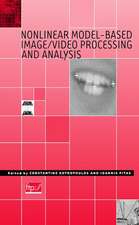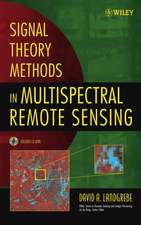Resistive, Capacitive, Inductive, and Magnetic Sensor Technologies: Series in Sensors
Autor Winncy Y. Duen Limba Engleză Paperback – 10 dec 2019
Resistive, Capacitive, Inductive, and Magnetic Sensor Technologies examines existing, new, and novel sensor technologies and—through real-world examples, sample problems, and practical exercises—illustrates how the related science and engineering principles can be applied across multiple disciplines, offering greater insight into various sensors’ operating mechanisms and practical functions. The book assists readers in understanding resistive, capacitive, inductive, and magnetic (RCIM) sensors, as well as sensors with similar design concepts, characteristics, and circuitry.
Resistive, Capacitive, Inductive, and Magnetic Sensor Technologies is a complete and comprehensive overview of RCIM sensing technologies. It takes a unique approach in describing a broad range of sensing technologies and their diverse applications by first reviewing the necessary physics, and then explaining the sensors’ intrinsic mechanisms, distinctive designs, materials and manufacturing methods, associated noise types, signal conditioning circuitry, and practical applications. The text not only covers silicon and metallic sensors but also those made of modern and specialized materials such as ceramics, polymers, and organic substances. It provides cutting-edge information useful to students, researchers, scientists, and practicing professionals involved in the design and application of sensor-based products in fields such as biomedical engineering, mechatronics, robotics, aerospace, and beyond.
| Toate formatele și edițiile | Preț | Express |
|---|---|---|
| Paperback (1) | 440.95 lei 6-8 săpt. | |
| CRC Press – 10 dec 2019 | 440.95 lei 6-8 săpt. | |
| Hardback (1) | 1334.90 lei 6-8 săpt. | |
| CRC Press – 9 dec 2014 | 1334.90 lei 6-8 săpt. |
Din seria Series in Sensors
- 26%
 Preț: 1356.09 lei
Preț: 1356.09 lei - 15%
 Preț: 489.26 lei
Preț: 489.26 lei - 15%
 Preț: 461.03 lei
Preț: 461.03 lei - 15%
 Preț: 498.29 lei
Preț: 498.29 lei - 22%
 Preț: 372.54 lei
Preț: 372.54 lei - 15%
 Preț: 514.47 lei
Preț: 514.47 lei - 5%
 Preț: 685.67 lei
Preț: 685.67 lei - 26%
 Preț: 989.77 lei
Preț: 989.77 lei - 22%
 Preț: 387.56 lei
Preț: 387.56 lei - 15%
 Preț: 613.49 lei
Preț: 613.49 lei - 22%
 Preț: 417.30 lei
Preț: 417.30 lei - 26%
 Preț: 1218.12 lei
Preț: 1218.12 lei -
 Preț: 435.17 lei
Preț: 435.17 lei -
 Preț: 500.30 lei
Preț: 500.30 lei - 22%
 Preț: 370.25 lei
Preț: 370.25 lei - 15%
 Preț: 489.26 lei
Preț: 489.26 lei - 15%
 Preț: 489.26 lei
Preț: 489.26 lei -
 Preț: 363.25 lei
Preț: 363.25 lei - 13%
 Preț: 309.58 lei
Preț: 309.58 lei - 24%
 Preț: 575.75 lei
Preț: 575.75 lei -
 Preț: 186.14 lei
Preț: 186.14 lei - 15%
 Preț: 568.28 lei
Preț: 568.28 lei - 20%
 Preț: 588.69 lei
Preț: 588.69 lei - 18%
 Preț: 779.21 lei
Preț: 779.21 lei - 18%
 Preț: 1792.25 lei
Preț: 1792.25 lei - 9%
 Preț: 904.47 lei
Preț: 904.47 lei - 9%
 Preț: 335.16 lei
Preț: 335.16 lei - 25%
 Preț: 1106.99 lei
Preț: 1106.99 lei
Preț: 440.95 lei
Nou
Puncte Express: 661
Preț estimativ în valută:
84.38€ • 87.56$ • 70.53£
84.38€ • 87.56$ • 70.53£
Carte tipărită la comandă
Livrare economică 17-31 martie
Preluare comenzi: 021 569.72.76
Specificații
ISBN-13: 9780367864651
ISBN-10: 0367864657
Pagini: 408
Dimensiuni: 156 x 234 x 27 mm
Greutate: 0.57 kg
Ediția:1
Editura: CRC Press
Colecția CRC Press
Seria Series in Sensors
ISBN-10: 0367864657
Pagini: 408
Dimensiuni: 156 x 234 x 27 mm
Greutate: 0.57 kg
Ediția:1
Editura: CRC Press
Colecția CRC Press
Seria Series in Sensors
Cuprins
Preface. Introduction. RCIM Sensor Definition and Terminologies. Resistive Sensors. Capacitive Sensors. Inductive Sensors. Magnetic Sensors. RCIM Sensor Circuits. Appendix. References and Resources. Index.
Notă biografică
Professor Winncy Y. Du (PE, ASME fellow) is the director of the Robotics, Sensor and Machine Intelligence Laboratory with the Department of Mechanical Engineering at San Jose State University, California, USA. She earned her Ph.D and second MS degree from Georgia Institute of Technology, Atlanta, USA; her first MS from West Virginia University, Morgantown, USA; and her BS from Jilin University, China. She has worked as a journal editor, engineer, and researcher; taught over ten different undergraduate and graduate courses; published numerous papers; and contributed to the books Smart Sensors and Sensing Technology and Modern Sensors, Transducers and Sensor Networks.
Descriere
This book examines existing, new, and novel sensor technologies and—through real-world examples, sample problems, and practical exercises—illustrates how the related science and engineering principles can be applied across multiple disciplines, offering greater insight into various sensors’ operating mechanisms and practical functions. Assisting























